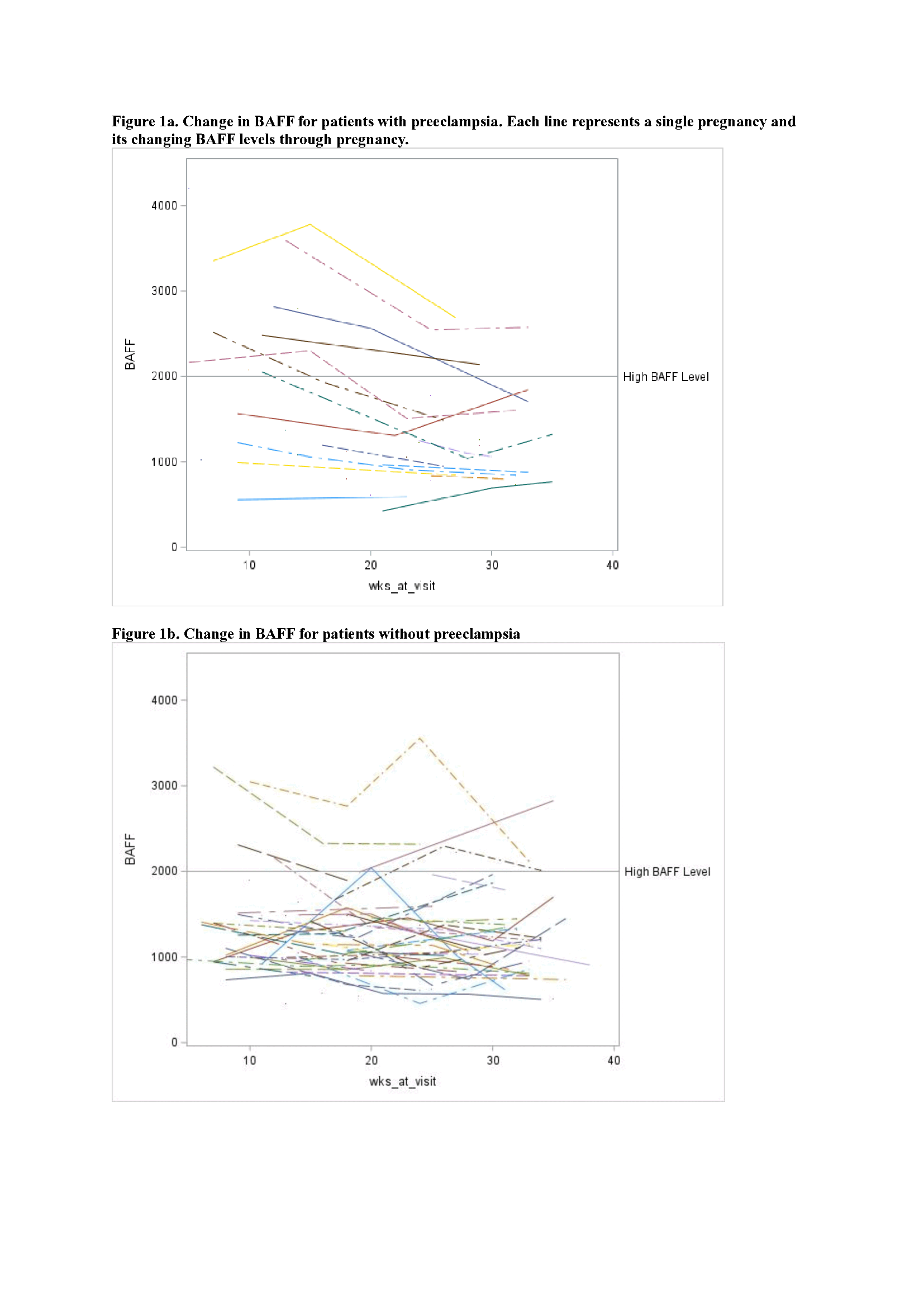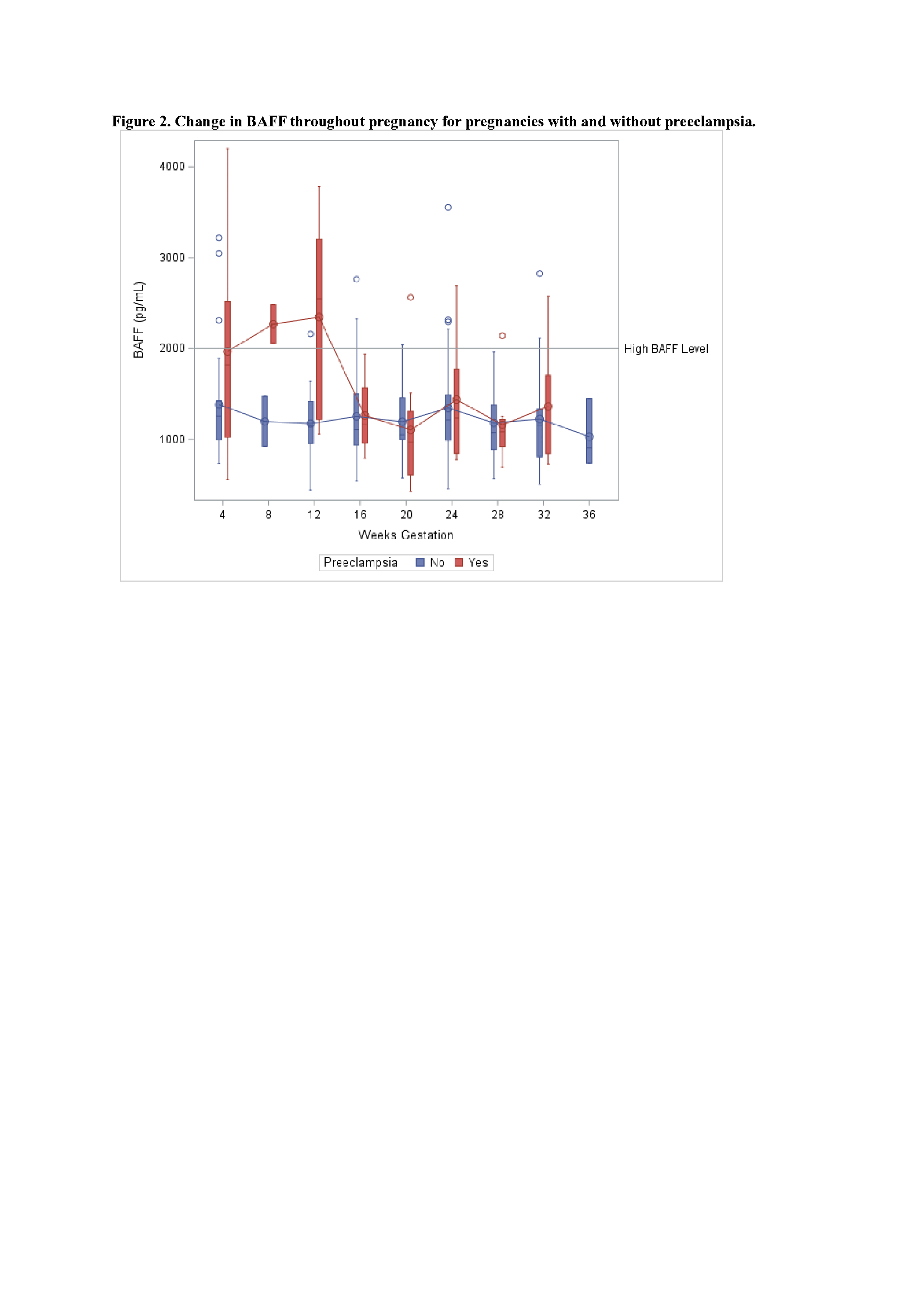Session Information
Session Type: Poster Session A
Session Time: 10:30AM-12:30PM
Background/Purpose: The B cell Activating Factor (BAFF) signaling pathway plays an important role in the selection, maturation, and survival of B cells; it consequently contributes to SLE pathogenesis. Serum BAFF levels have been found to correlate with SLE disease activity and dsDNA levels. BAFF also correlates with hypertension, gestational diabetes, pregnancy loss, and preeclampsia in pregnant women without SLE. There is limited knowledge of serum BAFF levels as measures of disease activity during pregnancy among women with SLE. We characterize the role of BAFF levels as markers of disease activity and potential targets for therapy to achieve disease control and minimize pregnancy complications.
Methods: This cohort was created from a prospective registry of pregnant adult women with SLE who met SLICC criteria in an academic rheumatology clinic. This registry included stored serum samples, vital signs, routine lab results, and pregnancy outcomes. Treating rheumatologists documented a physician global assessment (PGA) score at each visit. All BAFF and urine protein:creatinine ratio measurements occurred during routine clinic visits. Inclusion criteria for this analysis required enrollment prior to 30 weeks of gestation and known pregnancy outcome. We determined changes in BAFF levels throughout trimesters and the association of BAFF levels with SLE disease activity and adverse pregnancy outcomes.
Results: This study included 218 samples in 106 women with SLE. The average maternal age was 30.4 years and self-reported race was 5% Asian, 50% Black, and 39% White (Table 1). The median level of BAFF was higher in the 1st trimester compared to the 2nd and 3rd trimester measures (p=0.07). Most patients had either stable or decreasing BAFF levels over the course of pregnancy (Figure 1). Compared to pregnancies without preeclampsia, those that developed preeclampsia had significantly higher BAFF levels in the 1st trimester (2069 vs. 1178 pg/mL, p=0.006). These differences were not statistically significant in the 2nd and 3rd trimesters.
In models adjusted for age, obesity, and maternal race, women with high BAFF levels (≥ 2000) at their first measure prior to 20 weeks gestation were more likely to subsequently experience adverse pregnancy outcomes (HR: 2.48; 95% CI: 1.13, 5.46) and over 4 times more likely to develop preeclampsia (HR: 4.57; 95% CI 1.76, 11.88). Women with elevated BAFF were more likely to have elevated dsDNA or low complement, but not more likely to have increased SLE activity in the cutaneous, musculoskeletal, or renal systems during pregnancy.
Conclusion: As has been previously reported in a small cohort of women without rheumatic disease, this study found elevated BAFF in the first trimester of pregnancy was associated with later development of preeclampsia. While it was associated with dsDNA and complement, it was not associated with lupus nephritis, which is the primary predictor of preeclampsia within this cohort. This finding suggests that elevated BAFF early in pregnancy may be a novel risk factor for poor pregnancy outcomes in women with SLE.
Figure 1b. Change in BAFF for patients without preeclampsia
To cite this abstract in AMA style:
Sims C, Eudy A, Soneji S, Addae-Konadu K, Gilner J, James A, Federspiel J, Kovalik E, Lucas A, Neil L, Snyderman A, Clowse M. The Clinical Utility of Serum BAFF Levels in Pregnant Patients with SLE [abstract]. Arthritis Rheumatol. 2024; 76 (suppl 9). https://acrabstracts.org/abstract/the-clinical-utility-of-serum-baff-levels-in-pregnant-patients-with-sle/. Accessed .« Back to ACR Convergence 2024
ACR Meeting Abstracts - https://acrabstracts.org/abstract/the-clinical-utility-of-serum-baff-levels-in-pregnant-patients-with-sle/



